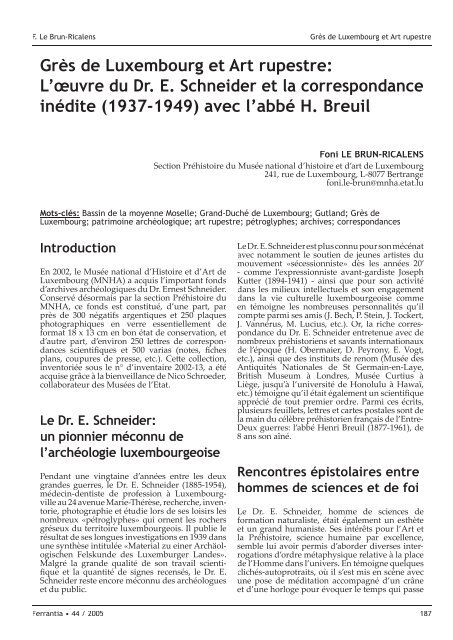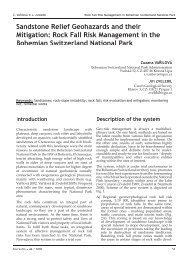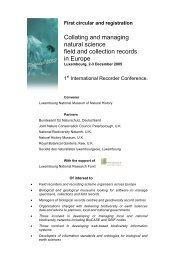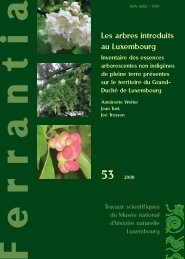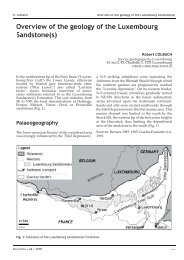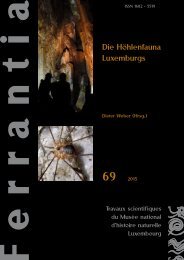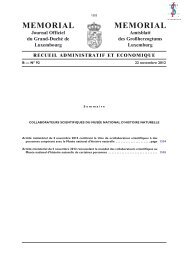Grès de Luxembourg et Art rupestre - Musée national d'histoire ...
Grès de Luxembourg et Art rupestre - Musée national d'histoire ...
Grès de Luxembourg et Art rupestre - Musée national d'histoire ...
You also want an ePaper? Increase the reach of your titles
YUMPU automatically turns print PDFs into web optimized ePapers that Google loves.
F. Le Brun-Ricalens Grès <strong>de</strong> <strong>Luxembourg</strong> <strong>et</strong> <strong>Art</strong> <strong>rupestre</strong>prendre <strong>de</strong>s fouilles en collaboration avec MarcelHeuertz (1904-1981) sous les auspices du Muséed’histoire naturelle, <strong>et</strong> réaliser <strong>de</strong>s publicationsscientifiques, parmi les premières après guerre,pour valoriser le patrimoine préhistorique luxembourgeois(Heuertz 1969).Extrait <strong>de</strong> la <strong>de</strong>rnière lere en date du 24 décembre1949 <strong>de</strong> l’abbé H. Breuil adressée au Dr. E.Schnei<strong>de</strong>r qui mourra 5 ans plus tard. Dans ceemissive, l’homme <strong>de</strong> science <strong>et</strong> <strong>de</strong> foi est toujoursaussi pragmatique, il recomman<strong>de</strong> un <strong>de</strong> ses jeunesélèves J.-L. Bau<strong>de</strong>t qui travaille sur <strong>de</strong>s sites <strong>de</strong> laforêt <strong>de</strong> Fontainebleau <strong>et</strong> effectue <strong>de</strong>s relationsentre artefacts découverts aux pieds <strong>et</strong> à proximité<strong>de</strong>s rochers gravés.«Il y a là un pas sérieux dans l’étu<strong>de</strong> <strong>et</strong> la datation<strong>de</strong> telles roches, qu’il serait intéressant <strong>de</strong> constateraussi ailleurs. Et ceci est l’obj<strong>et</strong> <strong>de</strong> cee lere que<strong>de</strong> vous en informer.»…«Je tiens maintenant à lar<strong>et</strong>raite du Collège <strong>de</strong> France <strong>et</strong> j’en profite pourvoyager, tant j’en ai la force: j’ai 73 ans. Je vous pried’agréer, avec mon bon souvenir, tous mes vœux<strong>de</strong> Noël <strong>et</strong> <strong>de</strong> l’an.»Avec humilité, ce n’est que dans cee <strong>de</strong>rnièrelere, qui sera la <strong>de</strong>rnière entre les <strong>de</strong>ux protagonistes,qu’il signe: «Prof(esseur) l’Abbé H. Breuil<strong>de</strong> l’Institut», alors qu’il a été nommé <strong>de</strong>puis1938.Le Dr. E. Schnei<strong>de</strong>r décè<strong>de</strong>ra en 1954 à l’âge <strong>de</strong>69 ans, soit sept années avant l’abbé H. Breuil.Contrairement à J.-L. Bau<strong>de</strong>t, qui succé<strong>de</strong>raensuite au prêtre à l’IPH, ils semblent qu’ils ne sesoient, à notre connaissance, jamais physiquementrencontrés. Pourtant, les archives du MNHArecèle <strong>de</strong>s ouvrages <strong>de</strong> H. Breuil qui portent unedédicace pour le Dr. E. Schnei<strong>de</strong>r; lui a-t-il remisceux-ci en main propre où par un intermédiaire ?PerspectivesLe <strong>de</strong>stin ayant permis à ces précieux documentsd’échapper aux malheurs <strong>de</strong> la guerre <strong>et</strong> aux affresdu temps, afin <strong>de</strong> garantir leur pérennité pour lesgénérations futures, il est heureux que ce patrimoineait pu rejoindre le domaine public. Dansla perspective <strong>de</strong> permere leur consultation<strong>et</strong> étu<strong>de</strong>, il est désormais nécessaire <strong>de</strong> trouverles moyens pour en assurer la conservationdans <strong>de</strong> bonnes conditions. L’important fondsque constitue les archives du Dr. E. Schnei<strong>de</strong>rest un précieux héritage qu’il faut en premierlieu restaurer, inventorier, archiver, copier pourpouvoir être accessible aux chercheurs travaillanttant sur l’<strong>Art</strong> <strong>rupestre</strong> luxembourgeois, que surl’historiographie <strong>de</strong>s préhistoriens du XX èmesiècle.La réalisation d’une telle initiative a pour but <strong>de</strong>Fig. 3: Extrait d’une correspondance du 1er septembre 1037 avec signature autographe <strong>de</strong> Henri Breuil.Ferrantia • 44 / 2005189
F. Le Brun-Ricalens Grès <strong>de</strong> <strong>Luxembourg</strong> <strong>et</strong> <strong>Art</strong> <strong>rupestre</strong>Tableau 1: Inventaire <strong>de</strong> la correspondance Breuil/Schnei<strong>de</strong>r conservée au MNHA (inventaire n° 2002-13).Datelieu <strong>de</strong>rédactionNature sommaire<strong>de</strong>ssin / signe à laplume1937-14 avril Paris références bibliographiques oui1937-1 septembre Paris à propos <strong>de</strong> figuration humaine oui1938-14 août Paris1938-16 novembre Paris1938-22 novembre Parisréférences bibliographiques +essai <strong>de</strong> chronologieà propos <strong>de</strong> gravuresanthropomorphes"Herringenberg <strong>et</strong> Berdorf-"Fünfter"à propos <strong>de</strong> gravuresanthropomorphes Berdorf-"Fünfter"ouiouiouiNombre <strong>de</strong>documents2 feuill<strong>et</strong>s (13 x20,5 cm)1 feuill<strong>et</strong> (13 x20,5 cm)2 feuill<strong>et</strong>s (13 x20,5 cm)1 carte (14 x10,5 cm)1 carte "postale"(14 x 8,7 cm)pages écrites observations enveloppe3 (1 recto-verso + 1recto)2 (1 recto-verso) non3 (1 recto-verso + 1recto)1938-22 décembre Paris courrier absent <strong>de</strong> l'enveloppe ? ? ?1938-31 décembre Paris références bibliographiques non1 carte postale(13, 5 x 9,8 cm)adresse Dr E. Schnei<strong>de</strong>r au Grand Hotel <strong>de</strong> Vittel(Vosges)1 recto carte à en tête <strong>de</strong> l'IPH déchirée pour ôter le timbre non1 recto1 recto"carte postale" écrit <strong>de</strong> la main <strong>de</strong> Breuil sur unecarte déchirée pour ôter le timbrecarte postale <strong>de</strong> Locmariaquer n° 756 (dolmen <strong>de</strong>pierres plates) Laboratoire Nel <strong>de</strong> Rennesnonnonnonoui (11,4 x 14,3cm)non1939-15 janvier Paris commentaires <strong>de</strong> gravures oui1 carte postale(14 x 9,1 cm)1 rectocarte postale <strong>de</strong> Locmariaquer n° 3030 (intérieur <strong>de</strong>Mané Lud) Laboratoire Nel <strong>de</strong> Rennesnon1939-14 mars Paris1939-23 juill<strong>et</strong> Abbevillehypothèses d'interprétation <strong>de</strong>gravuresfélicitations pour l'ouvrage <strong>de</strong> E.Schnei<strong>de</strong>r + hypothèsesd'interprétation <strong>de</strong> gravures +références bibliographiques1940-26 janvier Bor<strong>de</strong>aux ouiouioui1 carte postale(15 x 10,3 cm)3 feuill<strong>et</strong>s (13,5x 20,7 cm)1 feuill<strong>et</strong> (14 x17,7 cm)1 recto carte postale neutre non3 rectos Breuil fait <strong>de</strong>s fouilles à Abbeville non2 (1 recto-verso)papier à en-tête du Grand Hôtel Montré, rue <strong>de</strong>Montesquieu à Bor<strong>de</strong>aux (Breuil donne <strong>de</strong>s cours àBor<strong>de</strong>aux) déchiré en <strong>de</strong>ux au niveau du pli (traced'un ancien trombone) (Breuil ajoute "<strong>de</strong> l'Institut"après sa signature)non1940-10 mai 1945 juin Secon<strong>de</strong> guerre mondiale Breuil en Afrique du Sud1945-28 juill<strong>et</strong> Paris références bibliographiques oui1949-24 décembre Parisrecommandation <strong>de</strong> James-Louis Bau<strong>de</strong>tnon1 feuill<strong>et</strong> (13,5 x21,1 cm)1 feuille (21 x26,8 cm)2 (1 recto-verso)sur feuille pliée en 2 :3 (1 recto-verso + 1rectro)en tête IPH (Breuil ajoute "<strong>de</strong> l'Institut" après sasignature)en tête IPH pour feuille à plier en <strong>de</strong>ux (logo IPH àdroite) (Breuil ajoute "<strong>de</strong> l'Institut" après sasignature)oui (11,3 x 14,5cm) avec uneétiqu<strong>et</strong>te"contrôlé"oui (11 x 14,5cm)190 Ferrantia • 44 / 2005
F. Le Brun-Ricalens Grès <strong>de</strong> <strong>Luxembourg</strong> <strong>et</strong> <strong>Art</strong> <strong>rupestre</strong>convenablement géré <strong>et</strong> analysé ce patrimoine <strong>et</strong><strong>de</strong> le valoriser.Les personnes intéressées peuvent contacterl’auteur à l’adresse électronique suivante: foni.lebrun@mnha.<strong>et</strong>at.lu.Pour en savoir plus sur l’abbéH. Breuil, l’adresse électronique suivante peutêtre consultée: hp://www.mmsh.univ-aix.fr/iea/d_fichiers/ACIfauvelle.htmlRemerciementsJ’exprime ma cordiale gratitu<strong>de</strong> à Nico Schroe<strong>de</strong>rpour avoir assurer la conservation provisoire<strong>de</strong>s archives du Dr. E. Schnei<strong>de</strong>r, ainsi que meschaleureux remerciements à Laura Welter pouravoir patiemment déchiffré les documentsauto graphes <strong>de</strong> l’abbé H. Breuil <strong>et</strong> en avoir assuréleur transcription informatique. Je remercieégalement Lorraine Campbell pour avoir effectuéla traduction anglaise du résumé <strong>et</strong> Laurent Broupour son ai<strong>de</strong> à la préparation <strong>de</strong>s documents.BibliographieAnonyme 1966. - Henri Breuil (1877-1961),Catalogue d’exposition organisée par les soins<strong>de</strong> la Fondation Singer-Polignac (29 oct. 1966-31mars 1967), 72 p.Bau<strong>de</strong>t J.-L. 1955. - L’Abbé Breuil <strong>et</strong> son œuvre.Revue d’Anthropologie 1955: 124-127.Breuil H. 1956. - Science <strong>et</strong> religion: sont-ellesincompatibles? La Table Ron<strong>de</strong> 107: 168-177.Ewers M. & Arensdorff G. 2003. - Kulturelles Erbe inGefahr. Alarmieren<strong>de</strong>r Zustand archâologischerFelsbil<strong>de</strong>r. Bull<strong>et</strong>in <strong>de</strong> la Société préhistoriqueluxembourgeoise 23-24 (2001-2002): 13-19.Gaucher G. 1993. - Henri Breuil, Abbé. Bull<strong>et</strong>in <strong>de</strong>la Société préhistorique française, tome XC: 104-112.Heuertz M. 1953. - Survivance <strong>de</strong> signes préhistoriques,in Association pour l’Avancement <strong>de</strong>sSciences, Actes du Congrès <strong>de</strong> <strong>Luxembourg</strong>:423-425.Heuertz M. 1969. - Documents préhistoriques duterritoire luxembourgeois. Fasc. 1. Le milieunaturel. L’Homme <strong>et</strong> son œuvre. Publication duMusée d’Histoire Naturelle <strong>et</strong> <strong>de</strong> la Société <strong>de</strong>sNaturalistes luxembourgeois, 292 p.Hurel A. 2003. - Aux origines <strong>de</strong> l’Homme.Un prêtre, un savant dans la marche versl’institutionnalisation <strong>de</strong> la Préhistoire. L’AbbéHenri Breuil (1877-1961), in La revue pourl’Histoire du CNRS n° 8.Le Brun-Ricalens F. 2002. - «Mullerthal graffitis».Patrimoine archéologique en danger: unesituation alarmante. Bull<strong>et</strong>in du Musée <strong>national</strong>d’histoire <strong>et</strong> d’art, <strong>Luxembourg</strong>, Musée info 15:17-19.Le Brun-Ricalens F. 2003. - Acquisition <strong>de</strong>s archivesdu Dr. Ernest Schnei<strong>de</strong>r (1885-1954). Découverted’un pionnier <strong>de</strong> l’Archéologie luxembour-geoise. Bull<strong>et</strong>in du Musée <strong>national</strong> d’histoire <strong>et</strong>d’art, <strong>Luxembourg</strong>, Musée info 16: 28-31.Muller J.-J. 1996. - Marcel Heuertz - Gravures<strong>rupestre</strong>s. Textes établis par J.-J. Muller-Schnei<strong>de</strong>r d’après le manuscrit dactylographié<strong>de</strong> M. Heuertz. Bull<strong>et</strong>in <strong>de</strong> la Société préhisto-rique luxembourgeoise 18 (1996): 14-21.Schnei<strong>de</strong>r E. 1939. - Material zu einer ArchäologischenFelskun<strong>de</strong> <strong>de</strong>s Luxemburger Lan<strong>de</strong>s.Imprimerie Victor Bück, <strong>Luxembourg</strong>, 324 p.Schnei<strong>de</strong>r E. 1952. - Archäologische Spuren imRaume von Burglinster. An <strong>de</strong>r Burg. Eineheimatkundliche Monographie von Burglinster.Das Erste aus <strong>de</strong>r Reihe <strong>de</strong>r Kompass-Bücher<strong>de</strong>r Luxemburger Jugendhernergzentrale.Imprimerie J. Befort, <strong>Luxembourg</strong>, 16-20.Schnei<strong>de</strong>r E. 1968. - Vingt-sept camps r<strong>et</strong>ranchés duterritoire luxembourgeois levés par G. Lemmer.Documents édités <strong>et</strong> présentés par MarcelHeuertz. Imprimerie Victor Bück. Les Amis <strong>de</strong>sMusées.Skrotzky N. 1964. - L’Abbé Breuil <strong>et</strong> la Préhistoire.Paris, Seghers, 192 p.Sonneville-Bor<strong>de</strong>s (<strong>de</strong>) D. 1967. - La Préhistoiremo<strong>de</strong>rne. Editions Pierre Fanlac, Périgueux.Ferrantia • 44 / 2005191
F. Le Brun-Ricalens Grès <strong>de</strong> <strong>Luxembourg</strong> <strong>et</strong> <strong>Art</strong> <strong>rupestre</strong>Abstract of the presentation<strong>Luxembourg</strong> sandstone and rock art: The work of Dr. E. Schnei<strong>de</strong>r and his unpublished correspon<strong>de</strong>nce(1937-1949) with Abbot H. BreuilKeywords: Middle Mosel Basin; Grand Duchy of <strong>Luxembourg</strong>; Gutland; <strong>Luxembourg</strong> sandstone;archaeological heritage; rock art; p<strong>et</strong>roglyphs; archives; correspon<strong>de</strong>nceIn 2002, the 'Musée <strong>national</strong> d’histoire <strong>et</strong> d'art du <strong>Luxembourg</strong>'(<strong>Luxembourg</strong> National Museum of History and<strong>Art</strong>) has acquired the extensive archaeological archives<strong>de</strong>pot of Dr. Ernest Schnei<strong>de</strong>r. Preserved by the PrehistorySection at the MNHAL, these resource comprise almost300 negatives and 250 glass photographic plates, plusapproximately 250 leers of scientific correspon<strong>de</strong>nceand 500 various literary works (notes, cards, sk<strong>et</strong>ches,press clippings, <strong>et</strong>c.).Dr. E. .Schnei<strong>de</strong>r: an unknown pioneer of LuxemburgarchaeologyIn his free time over approximately twenty years duringthe interwar period (WW I and WW II), Dr. E. Schnei<strong>de</strong>r(1885–1954), a <strong>de</strong>ntist practising in <strong>Luxembourg</strong> City,searched for, ma<strong>de</strong> an inventory of and studied thenumerous 'p<strong>et</strong>roglyphs' that adorn the sandstone cliffsof the Luxemburg territory. He published his resultsin 1939 in a synthesis work entitled 'Material zu einerArchäologischen Felskun<strong>de</strong> <strong>de</strong>s Luxemburger Lan<strong>de</strong>s'.Despite the high standard of his work and the largenumber of findings documented, he remains relativelyunknown among archaeologists and the general public.Dr. E. Schnei<strong>de</strong>r is more well known for his patronage,with the particular support of young artists, of the'Secessionist' Movement as early as the 1920s, and alsofor his work in aca<strong>de</strong>mic circles and his commitment tothe cultural life of Luxemburg, as witnessed by severalindividuals whom he consi<strong>de</strong>red his friends (J. Bech, P.Stein, J. Tockert, <strong>et</strong>c.). However, the tremendous amountof correspon<strong>de</strong>nce sent by Dr. E. Schnei<strong>de</strong>r to numerousprehistorians and inter<strong>national</strong> scholars of the timeshow that he was also rated as a first-class scientist.Among these writings are several pages, leers and postcards wrien by the famous French prehistorian of theinterwar period, Abbot Henri Breuil (1877–1961).Correspon<strong>de</strong>nce with Abbot Henri Breuil: the 'Pope' ofPrehistoryAccording to preserved documents, Dr. E.Schnei<strong>de</strong>r andAbbot H. Breuil correspon<strong>de</strong>d with each other at leasta dozen wrien exchanges b<strong>et</strong>ween 1937 and 1949 inor<strong>de</strong>r to share their points of view on the interpr<strong>et</strong>ationof engravings found on <strong>Luxembourg</strong> sandstone cliffs.This paper presents two main themes: firstly, a generaloverview of the outstanding reference material compiledby Dr. Schnei<strong>de</strong>r on the 'p<strong>et</strong>roglyphs'; and, secondly,extracts from the correspon<strong>de</strong>nce that took placeb<strong>et</strong>ween the two scientists. The handwrien and 'illustrated'replies from Abbot H. Breuil show his interest inall forms of pre- and protohistoric <strong>Art</strong>. These documentsgive a new light on the research work conducted onsandstone formations in the first half of the 20 th century.192 Ferrantia • 44 / 2005


